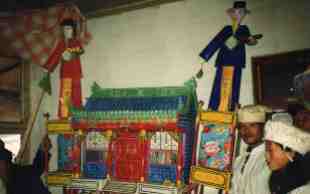Talking of commemorating the ancestors, for funerals in Yanggao the soul tablet (lingpai 灵牌, or shenwei 神位) (Daoist priests of the Li family, p.197) is carried by the son or grandson at the head of the sequence of processions throughout the day from scripture hall to soul hall, where it is placed on the table before the coffin while the Daoists sing a sequence of hymns; eventually it is burned late at night, on the eve of the burial, for the brief Escorting Away the Orphan Souls that follows the majestic Transferring Offerings ritual (my film, from 1.13.40).
Funeral, Yangguantun 2011: the soul tablet is carried from soul hall to scripture hall.
Since the 1980s the soul tablet has been made of paper, mounted on a chopstick stuck in a bread roll. But one day at a scripture hall I noticed an old soul tablet made of wood, written in Li Qing’s elegant hand in 1980 for the funeral of our host’s mother-in-law. So it transpires that the soul tablet has only been made of paper since the 1980s; previously, the bereaved family could make regular offerings at home over New Year before the more durable wooden version.
Left: wooden soul tablet, written by Li Qing, 1980.
Right: standard paper soul tablet, 2011.
Li Bin came across another old wooden soul tablet recently:

Indeed, along with subtle adaptations to ritual practice, funeral artefacts have changed significantly since the 1980s (Daoist priests, ch.19). Apart from the wooden soul tablet, no longer seen are the large rectangular wooden dou 斗 vessel filled with grain for the public rituals, or the layered wooden barrow for jiexian 接献 offerings from the returning female kin; the red lacquered wooden tray of offerings has been replaced by metal, and the elegant ceramic flask for Fetching Water by a plastic bottle.

Li Qing takes the red lacquered tray for funerary offerings, 1991.
My film, from 48.23.
Here the paper artefacts burned at the grave, though far less elaborate than in southeast China and Taiwan, have shown only modest innovations: since the 1990s the horse and cart have commonly been replaced by a car, and sometimes the deceased is provided with a mobile phone to ease other-worldly communication.
Paper artefacts to escort the deceased, 1991.
Note headgear denoting grades of kinship.
See also Tomb decoration, ancient and modern.
Perhaps the most significant recent innovations affecting access to ritual life were mobile phones and motor-bikes, allowing patrons to contact Daoists easily, and rapid movement for both. For an apparent threat to this culture from the state, see here.







Pingback: Recent updates on the Li family Daoists | Stephen Jones: a blog
Pingback: A new memorial stele | Stephen Jones: a blog
Pingback: A flawed funeral | Stephen Jones: a blog
Pingback: Altering ritual artefacts | Stephen Jones: a weblog - KRIPTIQ
Pingback: A 2019 retrospective | Stephen Jones: a blog
Pingback: Coronavirus 4: household Daoists in Shanxi | Stephen Jones: a blog
Pingback: One eye open, one eye closed – Dinesh Chandra China Story